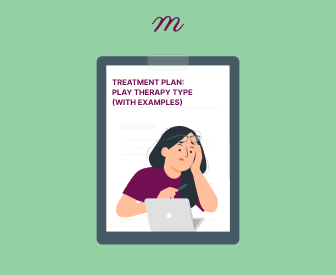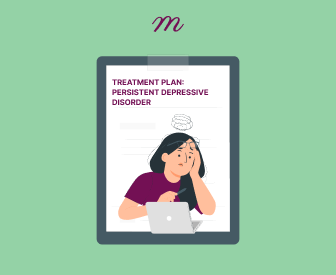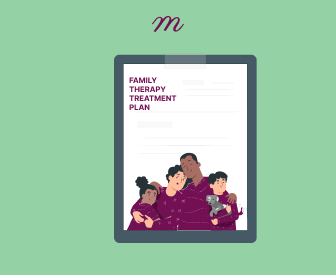Have your progress notes written for you automatically
There is often an underlying issue when people come to therapy battling depression, relationship issues, or job stress. Creating a self-esteem treatment plan is supporting clients through the nagging inner voice saying, “You’re not good enough.” Not only does it hurt them, but it builds walls around them, impacts their relationships, and keeps unhealthy patterns in place.
Throughout my clinical career, I’ve watched targeted self-esteem work create remarkable shifts. The hesitant “maybe I can’t” gradually evolves into “perhaps I could” and eventually blossoms into genuine confidence as clients develop healthier self-perception. Below, I share effective approaches for addressing poor self-regard, with particular focus on applying Fennell’s self-esteem framework—a method backed by contemporary research findings.
Understanding Self-esteem Treatment Plan Through Fennel’s Model: More Than Just “Feeling Good About Yourself”
Melanie Fennell’s model of low self-esteem has been a great help to my understanding of this phenomenon. Bad early experiences lead people to form a negative “bottom line” about themselves. “I’m unlovable” or “I’m worthless” or “I’m not enough.”
Because walking around consciously believing you’re worthless makes life unbearable, people develop what Fennell calls “conditional beliefs” and “rules for living”—basically survival strategies to protect themselves. “If I never make mistakes, no one will see how incompetent I really am” or “If I put everyone else first, maybe they won’t abandon me.”
These beliefs/rules work…until they don’t. When life threatens to break these beliefs/rules—maybe they make a mistake at work or someone gets angry at them despite their people-pleasing—everything falls apart:
- They predict disaster (“Everyone will finally see I’m a fraud.”)
- Anxiety spikes, and they fall back on safety behaviors (calling in sick, over-preparing, asking for excessive reassurance).
- Their attention zooms in on themselves in the worst way (self-consciousness).
- The self-criticism starts (“See? I knew you’d mess this up. You always do.”)
- And their mood tanks.
It’s a brutal cycle. The worse they feel, the more that negative bottom line feels TRUE, which makes them think more negatively, which makes them act in ways that actually confirm their worst fears about themselves.
I used this model with “Emma”, who came to me for work stress. Three sessions in, we discovered her belief that she was “fundamentally defective” drove her to work 70-hour weeks, triple-check everything, and never delegate—which eventually led to burnout, mistakes from exhaustion, and a reinforced belief in her “defectiveness.” Mapping this out was like turning on a light in a dark room for her.
Evidence-Based Treatment Plan: What Works?
The treatment plan outlined is based on Fennell’s model. Following it helps ensure a comprehensive approach to your clients’ low self-esteem.
Assessment Phase
Before diving into treatment, I spend time understanding:
- How bad is it? (Using something like the Rosenberg Self-Esteem Scale (RSE), but honestly, just listening to how they talk about themselves tells me a ton.)
- Where did it come from? (Family messages? School bullying? Workplace trauma?)
- What keeps it going? (Perfectionism? Avoiding challenges? Constant comparisons?)
- How is it messing up their life? (Relationships? Career? Health?)
- What else is happening? (Depression? Anxiety? Eating issues?)
Self-esteem Treatment Plan Phase 1: Psychoeducation and Engagement
First things first—help them understand what’s happening. I’m big on metaphors here.
With Marcus (all fictional names), a 40-year-old who couldn’t understand why his successful career didn’t make him feel better about himself, I used the “house built on sand” metaphor. “You’ve built this impressive career, Marcus—beautiful house, right? But the foundation underneath is unstable. Every achievement is like adding another story to a house that could sink at any moment. No wonder you’re exhausted.”
This helped us come to an understanding and get on the same page with the treatment. My client finally understood what was going on and the implications of his problem.
Presenting Fennell’s model often creates those moments. Clients who thought they were broken suddenly see patterns that make sense. “You mean there’s an explanation for why I feel this way?”
Self-esteem Treatment Plan 2: Identifying and Challenging the Bottom Line
Now comes the detective work:
- Uncovering the bottom line: I’ll use the downward arrow technique, basically asking “And what would that mean about you?” until we hit bedrock. Or we’ll look for themes in their automatic thoughts—”I notice you call yourself ‘stupid’ a lot. Where’d you learn that about yourself?”
- Reality-testing: Two columns—evidence for and against the belief. Clients can rattle off twenty “proofs” they’re worthless, but struggle to find one contradiction. We dig for:
- Accomplishments they’ve dismissed (“Yeah, but anyone could have done that.”)
- Qualities others appreciate (“My friend says I’m a good listener, but that’s nothing special.”)
- Times they’ve handled tough situations well.
- Double standards (“Would you judge your best friend by these impossible standards?”)
- Building a new narrative: This isn’t about plastering over cracks with toxic positivity. It’s about developing a more accurate self-view.
A client I had, a middle school teacher, believed she was “fundamentally incompetent” despite 15 years of successful teaching and numerous awards. We gradually developed: “I have strengths and weaknesses, like everyone. Making mistakes is part of being human, not evidence I’m incompetent.”
Self-esteem Treatment Plan Phase 3: Modifying Rules for Living
Those rigid rules that once protected them are now prisons. I listen for:
- Absolute language (“I must never show weakness.”)
- Disproportionate fear reactions (“If I say no to this request, everyone will hate me.”)
- Excessive guilt when breaking rules (“I took a lunch break and felt terrible about it.”)
For each rule, we:
- Honor its original purpose (“This rule protected you when you were little and powerless.”)
- Evaluate its current usefulness (“Is it still serving you or hurting you?”)
- Create more flexible alternatives
- Test them in real life
“James” operated with “I must never inconvenience others” his entire life. The cost? Burnout, resentment, and health problems from stress. We developed “My needs matter too. Most people respect honesty about limitations more than martyrdom.”
His first “no” at work nearly gave him a panic attack. But when his colleague simply said “No problem, I’ll ask Sarah instead,” it cracked open his belief system.
Self-esteem Treatment Plan Phase 4: Behavioral Work
Thinking differently isn’t enough—clients need to act differently, too:
- Ditching safety behaviors: Those things they do to protect themselves actually keep low self-esteem alive. The nurse who triple-checks every medication chart because she deeply fears making a mistake. The dad who never shares personal stories at family gatherings to avoid potential judgment. The graduate student who rewrites emails eight times before sending. We work together to gradually reduce these exhausting routines.
- Behavioral experiments: Structured activities to test predictions. When “Rina” believed “If I speak up in a crowd, people will think I’m stupid,” we designed graduated challenges—telling one prepared fact in a small gathering, then building from there.
- Skill-building: Many clients need practical tools:
- Assertiveness training
- Social skills practice
- Self-compassion exercises
- Activities that bring pleasure and mastery
- Taming the inner critic: This might involve thought records, compassionate letter-writing, or mindfulness techniques.
One approach I love is having clients record their self-criticism in their own voice and then creating a compassionate response. Hearing that harsh voice played back is eye-opening—”Do I really talk to myself that way?”
Self-esteem Treatment Plan Phase 5: Consolidation and Relapse Prevention
As we wrap up:
- We create a personalized map of how their low self-esteem developed and what keeps it going.
- Identify triggers and vulnerable moments.
- Develop specific coping tools for high-risk situations.
- Practice skills in increasingly challenging contexts.
- Shift focus from “doing self-esteem work” to embodying a new relationship with themselves.
Group-Based Interventions
Group therapy for self-esteem is incredibly powerful. There’s something almost magical about sitting in a circle with others who nod in understanding when they share those thoughts they’ve been afraid to voice. I’ve seen clients’ eyes widen with relief when they realize they’re not alone in their inner struggles.
When clients who’ve been struggling with perfectionism in individual therapy hear others describe identical thought patterns, they often experience profound relief. Many report breakthrough moments, saying things like “I finally believed it wasn’t just me being broken.” The feedback people receive from peers carries a weight that therapist observations—helpful as they are—simply can’t match.
Most effective self-esteem groups run for about 10 sessions. The first couple typically focus on understanding how self-esteem forms and functions, followed by several sessions challenging those stubborn core beliefs. The middle sessions often involve real-world experiments and practical skills development, with plenty of sometimes awkward but always valuable role-playing exercises. Groups usually conclude with sessions on preventing relapse, recognizing that life will inevitably test these newly formed beliefs.
Measuring Progress
Finally, throughout the whole treatment process, I track progress through:
- Questionnaires, especially those that they have filled previously in the assessment phase (though I take these with a grain of salt—sometimes scores can get worse as awareness increases).
- Journaling themes.
- Behavior changes (Are they speaking up more? Taking appropriate risks?).
- Feedback from others (when appropriate).
Clinical Challenges and Solutions
Sometimes challenges can arise when creating a low self-esteem treatment plan. Here are some that I have encountered and recommendations on how to navigate them. Remember: tailoring treatment to your client’s special needs is the best way to ensure engagement and progress!
Challenge 1: The Self-Esteem Versus Depression Question
It is the chicken-or-egg dilemma: “Am I treating low self-esteem or depression?” They feed each other—low self-esteem makes you vulnerable to depression, while depression further erodes self-esteem.
I focus treatment based on:
- Which showed up first historically
- What the client thinks is primary (“I get depressed because I hate myself” versus “I hate myself when I’m depressed”)
- What’s causing the most functional problems
With severe depression, I usually address the basics first—sleep, appetite, suicidal thoughts—then weave in self-esteem work as they stabilize.
Challenge 2: Addressing Resistance
Resistance often looks like:
- Fear of change: “If I stop beating myself up, I’ll become lazy/arrogant/selfish”
- Identity attachment: “But this is who I’ve always been.”
- Secret benefits: The low-key perks of low self-esteem, like avoiding challenges.
I address these directly. With the “I’ll get lazy” fear, I ask, “Has criticism ever been your best motivator? Or do you actually do your best work when you feel capable and supported?”
Challenge 3: Cultural Considerations
Self-esteem isn’t understood the same way across cultures. What looks like “low self-esteem” might reflect cultural values of humility or collective identity.
I always consider:
- Family messages about self-worth.
- Cultural norms about self-expression.
- Individual versus group emphasis.
For clients from collectivistic backgrounds, framing self-esteem around contribution to family/community often resonates more than individual achievement or self-expression.
Some Final Thoughts
Building healthy self-esteem isn’t quick or easy. But research backs what we’ve been seeing in our practices: a well-laid-out self-esteem treatment plan works.
I used to dread the paperwork that came with tracking this complex work. That’s where apps like Mentalyc have been a game-changer for my practice. The time I save on documentation gives me back mental space to be present with my clients.
Sometimes I’ll look back through six months of session notes and show a client how far they’ve come—from the person who couldn’t accept a compliment without deflecting to someone who can acknowledge their own worth without breaking into hives. That journey from inner critic to inner ally doesn’t just make people feel better—it fundamentally changes what they believe is possible in their lives. And honestly, witnessing that transformation is why, despite the challenges, I still love this work after all this time.










